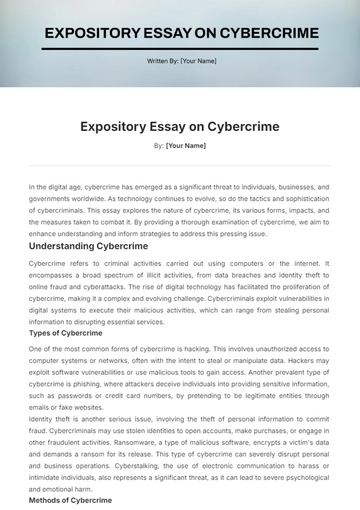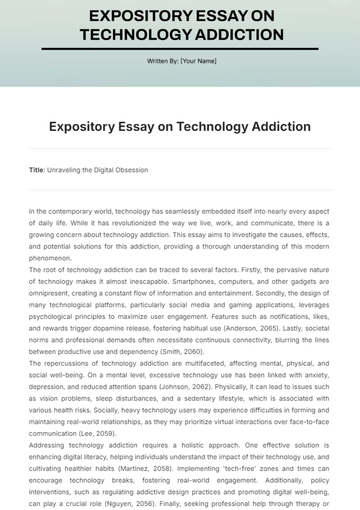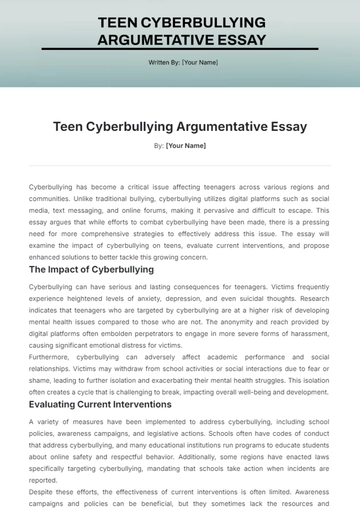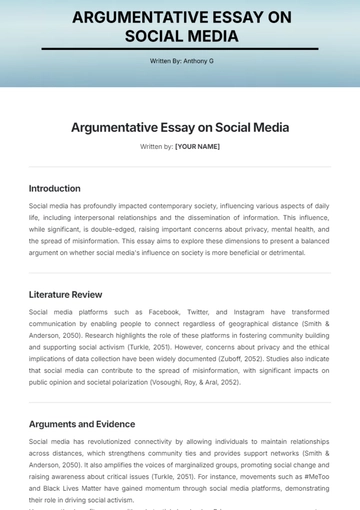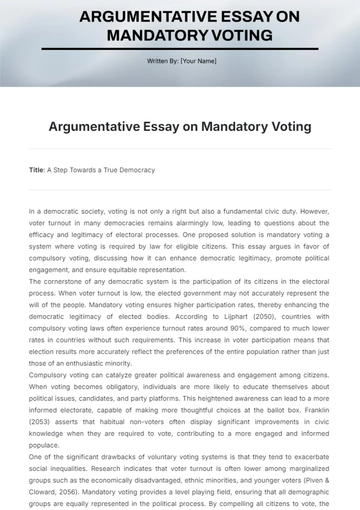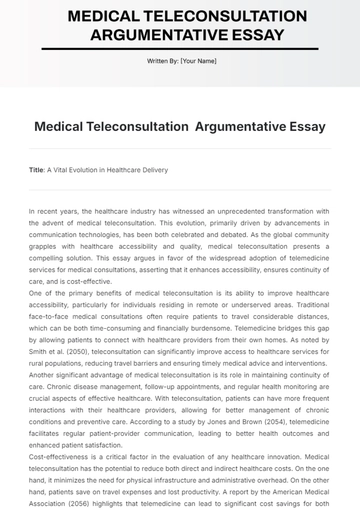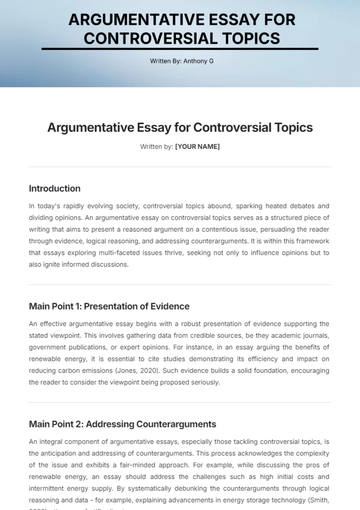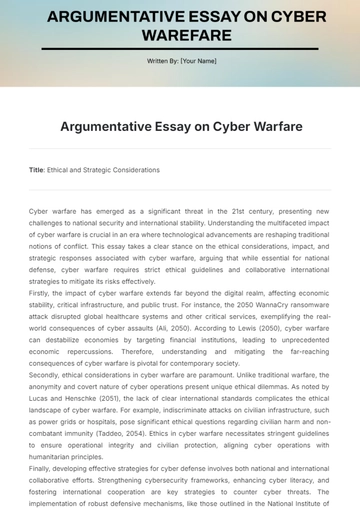Free Expository Essay on Cybercrime
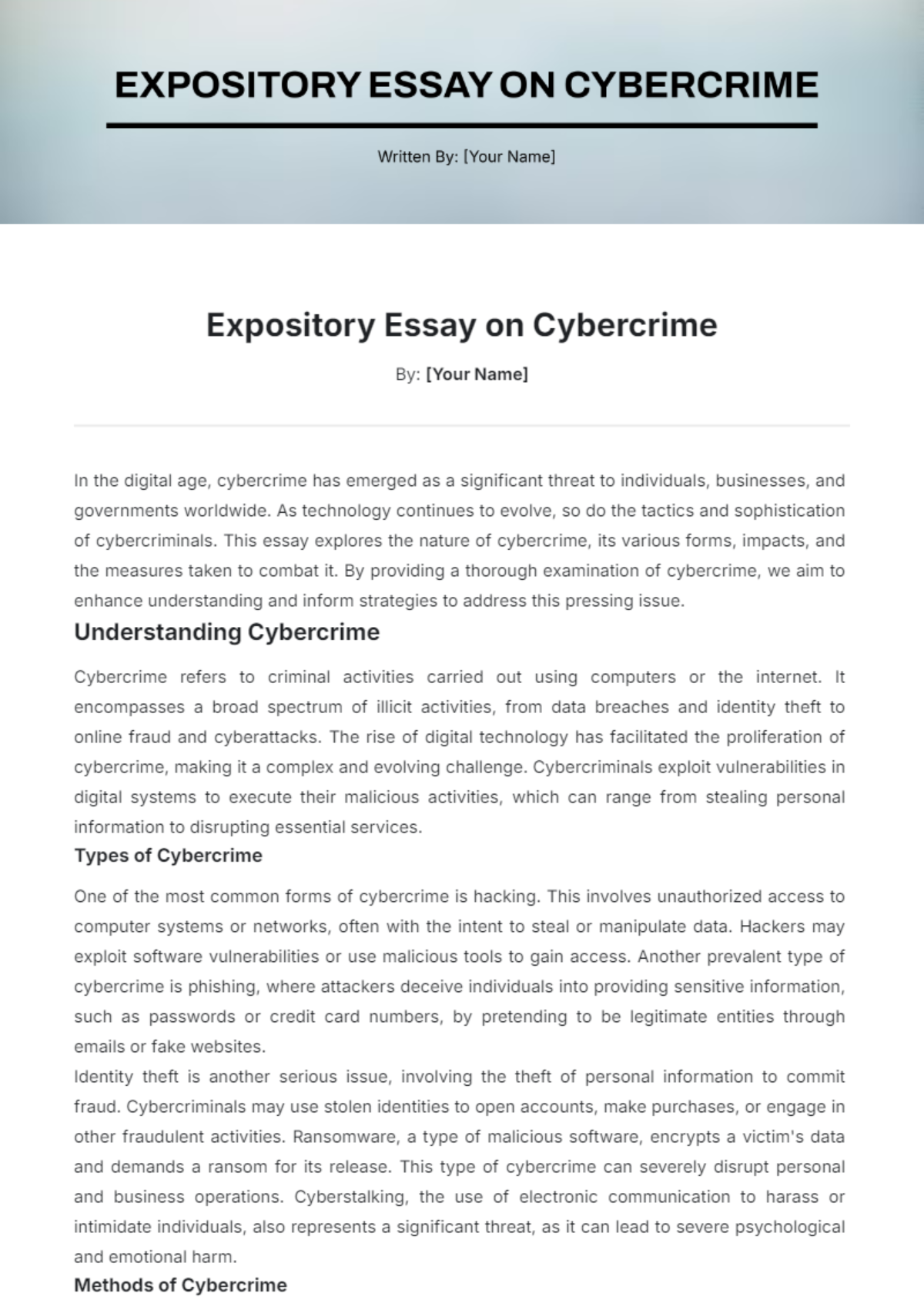
By: [Your Name]
In the digital age, cybercrime has emerged as a significant threat to individuals, businesses, and governments worldwide. As technology continues to evolve, so do the tactics and sophistication of cybercriminals. This essay explores the nature of cybercrime, its various forms, impacts, and the measures taken to combat it. By providing a thorough examination of cybercrime, we aim to enhance understanding and inform strategies to address this pressing issue.
Understanding Cybercrime
Cybercrime refers to criminal activities carried out using computers or the internet. It encompasses a broad spectrum of illicit activities, from data breaches and identity theft to online fraud and cyberattacks. The rise of digital technology has facilitated the proliferation of cybercrime, making it a complex and evolving challenge. Cybercriminals exploit vulnerabilities in digital systems to execute their malicious activities, which can range from stealing personal information to disrupting essential services.
Types of Cybercrime
One of the most common forms of cybercrime is hacking. This involves unauthorized access to computer systems or networks, often with the intent to steal or manipulate data. Hackers may exploit software vulnerabilities or use malicious tools to gain access. Another prevalent type of cybercrime is phishing, where attackers deceive individuals into providing sensitive information, such as passwords or credit card numbers, by pretending to be legitimate entities through emails or fake websites.
Identity theft is another serious issue, involving the theft of personal information to commit fraud. Cybercriminals may use stolen identities to open accounts, make purchases, or engage in other fraudulent activities. Ransomware, a type of malicious software, encrypts a victim's data and demands a ransom for its release. This type of cybercrime can severely disrupt personal and business operations. Cyberstalking, the use of electronic communication to harass or intimidate individuals, also represents a significant threat, as it can lead to severe psychological and emotional harm.
Methods of Cybercrime
Cybercriminals employ various techniques to carry out their activities. Social engineering is one such method, where attackers manipulate individuals into divulging confidential information by exploiting psychological manipulation. Malware, including viruses, worms, and trojans, is another tool used to harm or exploit computer systems. Distributed Denial of Service (DDoS) attacks overwhelm a network or website with traffic, rendering it inaccessible to users and causing significant disruptions.
Impact of Cybercrime
The consequences of cybercrime are extensive and far-reaching. Financial losses are a primary concern, as individuals and businesses may face substantial costs related to data breaches, ransom payments, and legal fees. Additionally, organizations affected by cybercrime often suffer reputational damage, leading to a loss of customer trust and potential long-term impacts on their operations.
Privacy violations are another serious issue, as victims may find their personal information exposed or misused by criminals. Cyberattacks, such as DDoS attacks, can disrupt essential services and operations, affecting everything from online shopping to healthcare services. The disruption caused by these attacks can have widespread implications for both individuals and organizations.
Solutions and Recommendations
To address the growing threat of cybercrime, several preventive measures and solutions can be implemented. Enhanced security practices, such as using strong passwords, multi-factor authentication, and regularly updating software, can help protect against cyberattacks. Additionally, cybersecurity training for individuals and employees is crucial in educating them about potential threats and safe online practices.
Data encryption is another effective measure, ensuring that even if sensitive information is intercepted or stolen, it remains unreadable without the decryption key. On a broader scale, stronger legislation and international cooperation are essential for combating cybercrime. Governments and regulatory bodies need to enforce and update laws related to cybercrime, while international collaboration can facilitate effective law enforcement and prosecution.
Conclusion
Cybercrime presents a significant and evolving threat in today's digital world. By understanding its various forms, and impacts, and the measures to counteract it, individuals and organizations can better safeguard themselves against these malicious activities. Ongoing efforts in cybersecurity, legislative action, and public education are crucial in mitigating the risks associated with cybercrime and protecting the digital realm. As technology continues to advance, a proactive and informed approach to cybercrime will be essential in ensuring a secure and resilient digital environment.
- 100% Customizable, free editor
- Access 1 Million+ Templates, photo’s & graphics
- Download or share as a template
- Click and replace photos, graphics, text, backgrounds
- Resize, crop, AI write & more
- Access advanced editor
The Expository Essay on Cybercrime Template from Template.net is fully editable and customizable, making it easy to craft an informative essay on the complex topic of cybercrime. Its well-structured layout allows you to organize your content effectively, ensuring clarity and professionalism. Ideal for students, educators, and writers, this template offers flexibility, enabling you to adjust it to any style or academic requirement with ease.





